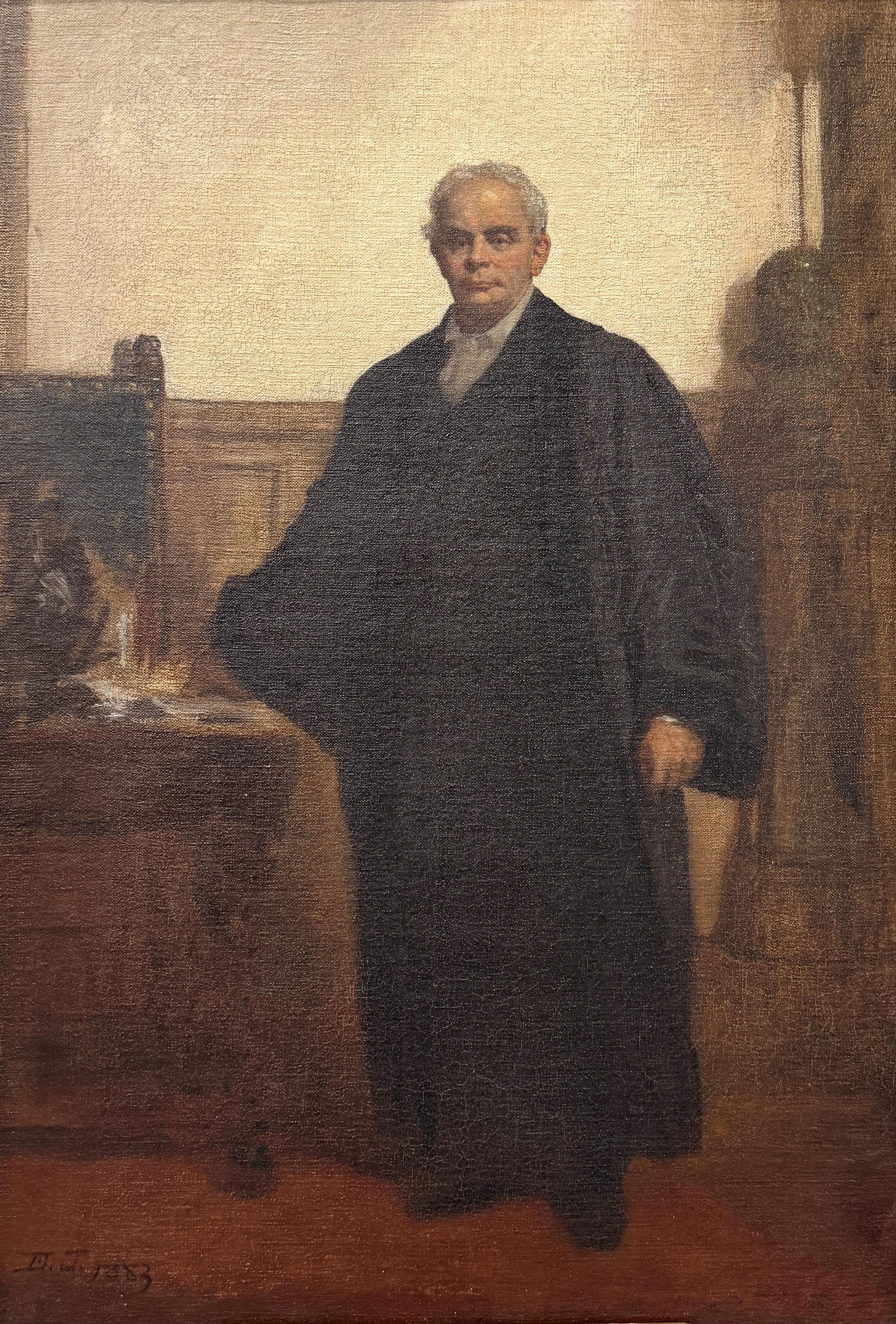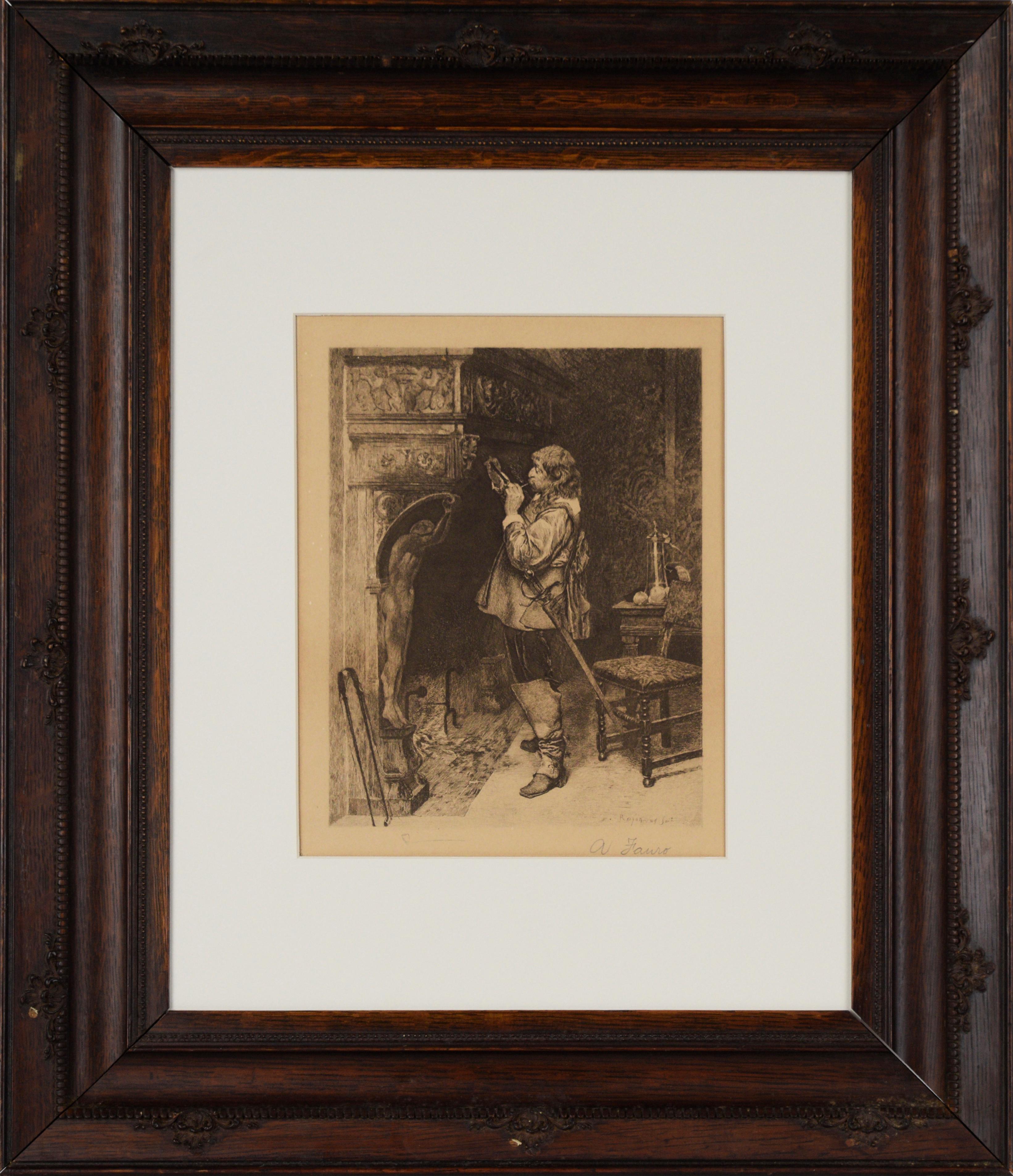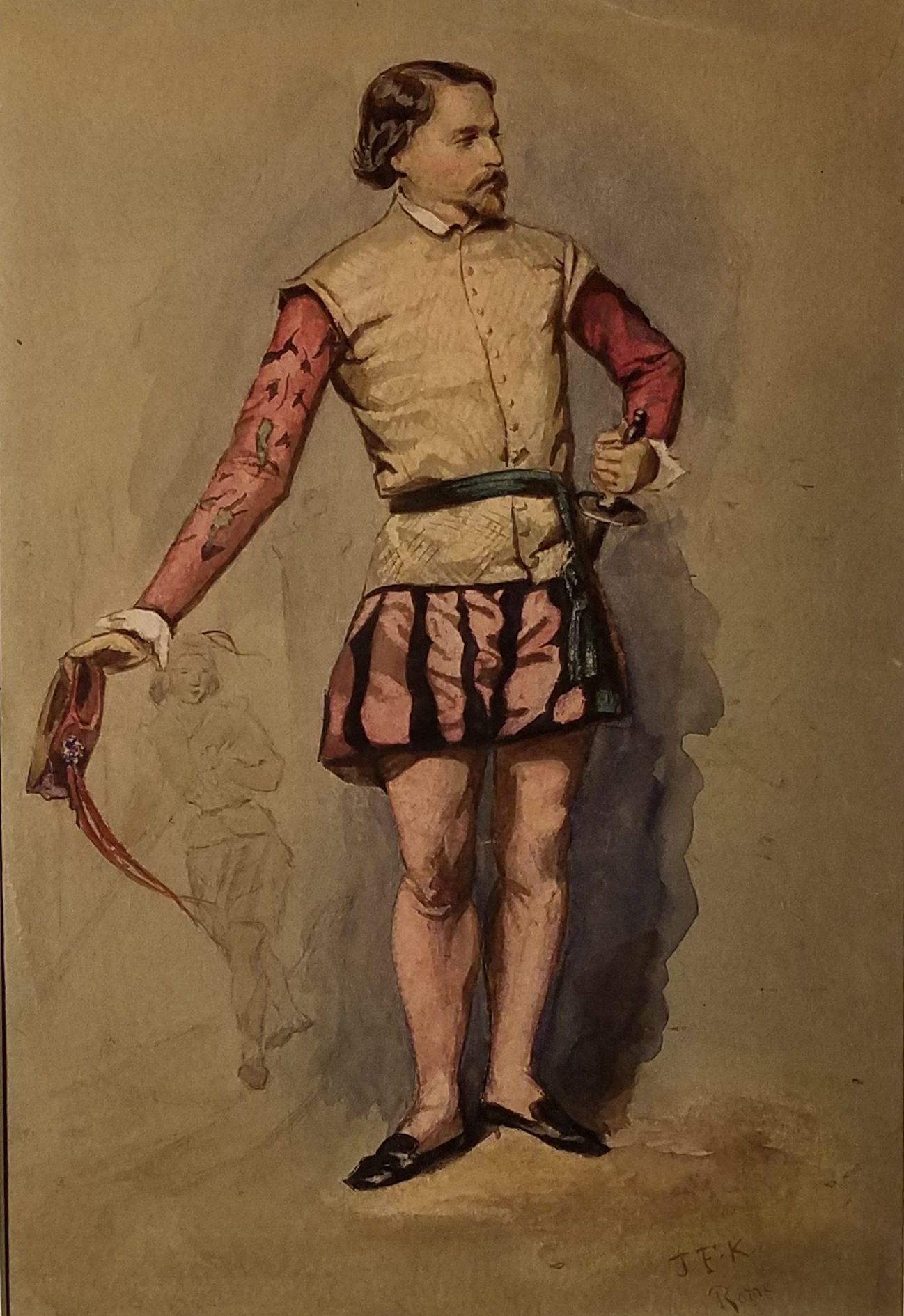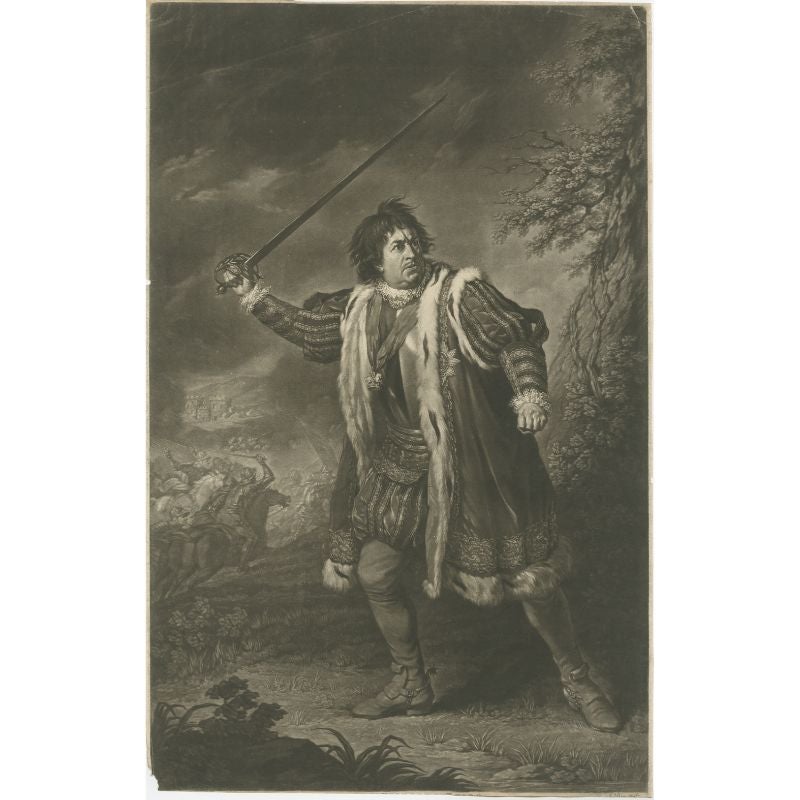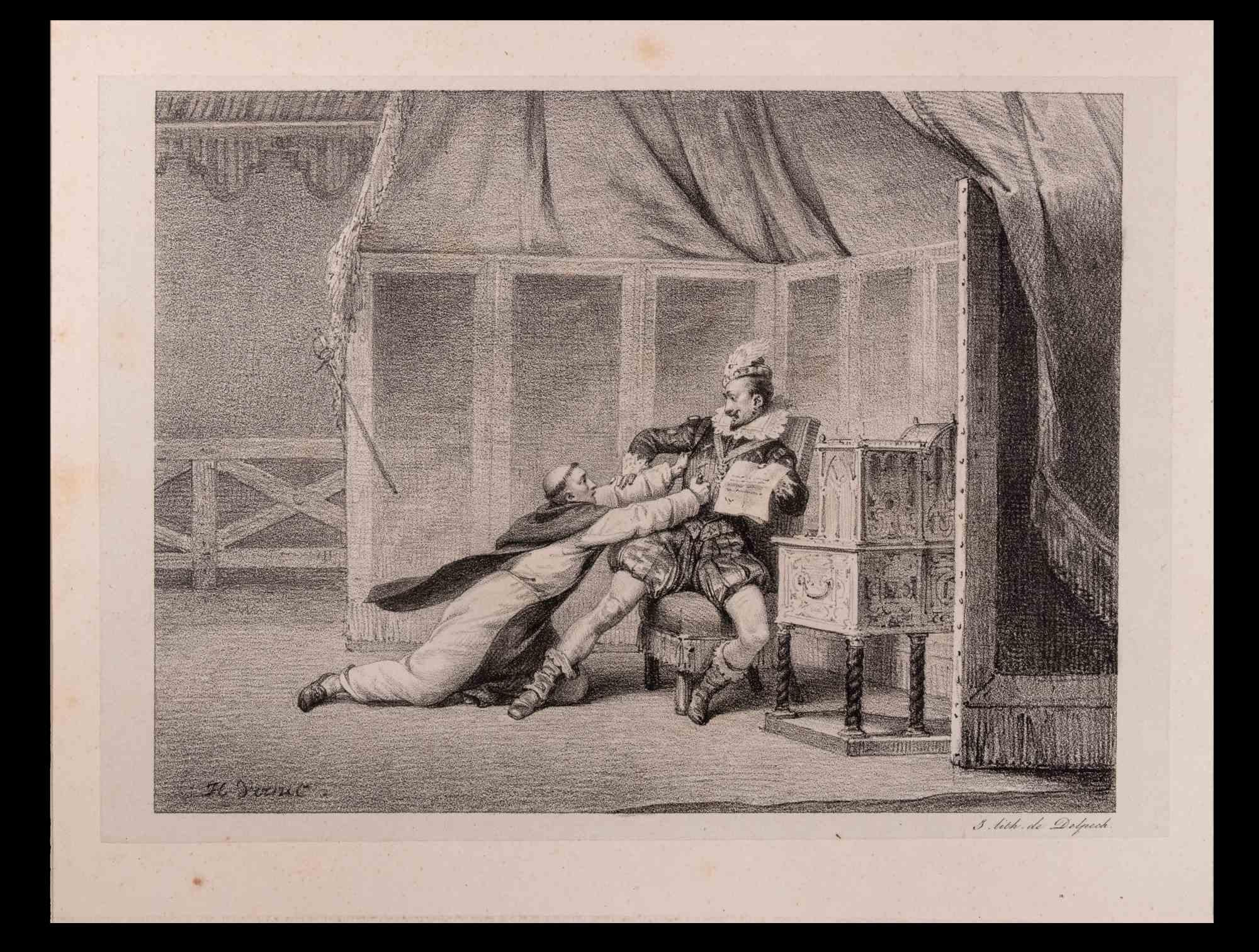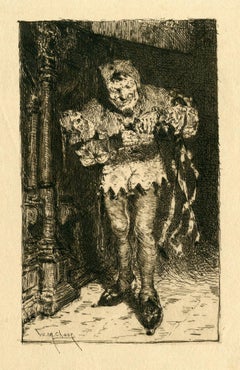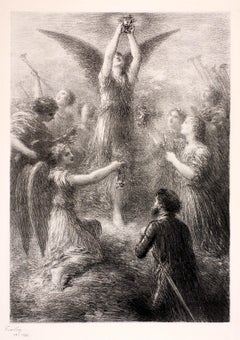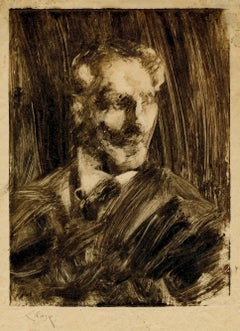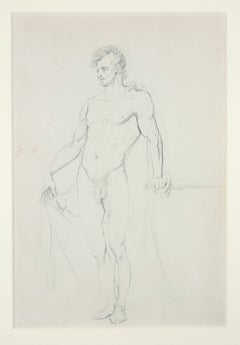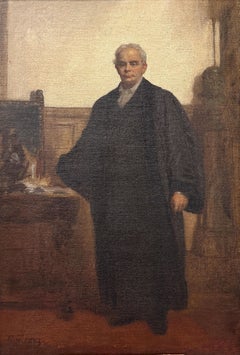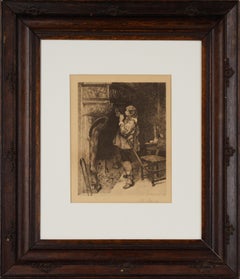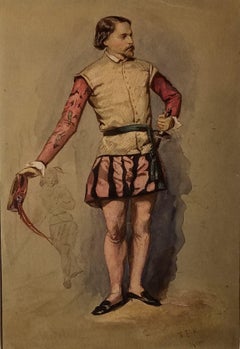Items Similar to John Phillip Kemble as Hamlet, Act V, Scene I
Want more images or videos?
Request additional images or videos from the seller
1 of 5
Eastman JohnsonJohn Phillip Kemble as Hamlet, Act V, Scene I1845
1845
$24,000
£18,122.23
€21,025.50
CA$33,727.54
A$37,577.24
CHF 19,617.10
MX$456,237.77
NOK 246,574.11
SEK 233,072.44
DKK 156,952.86
About the Item
Signed and dated (on back) "January 1845/ J.E.J."
Provenance:
Mr. and Mrs. Bertram Rowland, Buckingham, PA
Mr. and Mrs. Edward Abraham, West Chester, PA
Hirschl & Adler Galleries, 1974, (APG 7462)
Don Joint, artist
Reference: Letter from Patricia Hills, Cambridge, MA, November 11, 1989 (Hirschl & Adler Galleries Archive)
Note: Ms. Hills states "this drawing has all of the characteristics of Johnson's early charcoal drawings, and in my opinion it is by Johnson's hand". She continues, "Done in 1845, the drawing is an ambitious work for an artist only 21 years old and is unique in that it is a small, full figure portrait.
Nevertheless, the characteristics are unquestionably those of Johnson: the subtle chiaroscuro modeling to the face the typical delineation of the lips (with Cupid's bow precision), the nicely detailed texture of the fir, and the large soulful eye. The handwriting on the verso matches the inscriptions on other works which Johnson did at this time".
This drawing depicts the great Shakespearean actor John Phillip Kemble (1757-1923) in the role of Hamlet. Johnson's drawing was done after a portrait of the actor by Sir Thomas Lawrence of 1801 (Tate Gallery, London), which was subsequently engraved in mezzotint in 1805 by S. W. Reynolds (1773-1835) recorded in Garlick 1989; 451d. An impression of the mezzotint is in the British Museum.
Frame: 28 1/2 x 24"
Sheet: 19 3/4 x 14 3/4"
- Creator:Eastman Johnson (1824-1906, American)
- Creation Year:1845
- Dimensions:Height: 28.5 in (72.39 cm)Width: 24 in (60.96 cm)
- Medium:
- Period:
- Condition:Excellent original condition.
- Gallery Location:Fairlawn, OH
- Reference Number:Seller: FA88031stDibs: LU1402082533
About the Seller
5.0
Recognized Seller
These prestigious sellers are industry leaders and represent the highest echelon for item quality and design.
Gold Seller
Premium sellers maintaining a 4.3+ rating and 24-hour response times
Established in 1978
1stDibs seller since 2013
808 sales on 1stDibs
Typical response time: <1 hour
Associations
International Fine Print Dealers Association
- ShippingRetrieving quote...Shipping from: Fairlawn, OH
- Return Policy
Authenticity Guarantee
In the unlikely event there’s an issue with an item’s authenticity, contact us within 1 year for a full refund. DetailsMoney-Back Guarantee
If your item is not as described, is damaged in transit, or does not arrive, contact us within 7 days for a full refund. Details24-Hour Cancellation
You have a 24-hour grace period in which to reconsider your purchase, with no questions asked.Vetted Professional Sellers
Our world-class sellers must adhere to strict standards for service and quality, maintaining the integrity of our listings.Price-Match Guarantee
If you find that a seller listed the same item for a lower price elsewhere, we’ll match it.Trusted Global Delivery
Our best-in-class carrier network provides specialized shipping options worldwide, including custom delivery.More From This Seller
View AllKeying Up - The Court Jester
By William Merritt Chase
Located in Fairlawn, OH
Keying Up - The Court Jester
Etching with drypoint, 1879
Signed in the plate lower left corner (see photos)
Proof before engraved title and engraved names
Printed on thin light golden Japanese tissue paper
In the final state, with engraved titled and typeface engraved artist’s signature below the image
Condition: excellent
Plate size: 6-5/8 x 4-1/4"
According to Pisano, this image was very popular during Chase’s life. It is based on his famous painting, Keying Up-The Court Jester, in the collection of the Pennsylvania Academy of Fine Arts. The painting was created in Munich during the artist’s studies there. It was exhibited in the 1876 Centennial Exhibition in Philadelphia where it won a Medal of Honor and helped establish the artist’s reputation as a leading American painter.
Chase, always conscious of self promotion, created the etching and had numerous impressions printed. He sold them for a modest price to increase his fame. The etching was later published in Sylvester R. Koehler, American Art Review, September 1878. It was for this American Art Review printing that the engraved titled and type face signature below the image were added to the plate.
This example was part of a group of impressions that came down in the Chase family via his daughter Dorothy Bremond Chase, his third daughter. They were acquired at auction in a single auction lot, housed in a paper board folder. The consignor was Associated American Artist’s as they were liquidating their stock prior to closing the gallery.
Dorothy was the subject of Chase’s painting, My Little Daughter Dorothy. C. 1894, in the collection of the Detroit Institute of Arts as well as numerous other portraits of her.
Reference: Pisano/Bake, Volume 1, Pr. 3, illustrates the rare 1st state, this being a 2nd state before any other the engraved title and Chase's name in the bottom margin which are found in the third state.
Artist bio in file (Chase)
In 1883 Chase was involved in the organization of an exhibition to help raise funds for a pedestal for the Statute of Liberty. The exhibition featured loans of three works by Manet and urban scenes by the Italian Impressionist Giuseppe de Nittis. Both artists influenced Chase's Impressionistic style that gave rise to a series of New York park scenes. It is also thought that he was influenced by John Singer Sargent's In the Luxembourg Gardens (1879) which was exhibited in New York at this time. Indeed, Chase had met Sargent in Europe in 1881, the two men becoming lifelong friends with Sargent painting Chase's portrait in 1902.
On another European trip in 1885, Chase met James McNeill Whistler in London. While Whistler had a reputation for being difficult, the two artists got along famously and agreed to paint one another's portrait. Eventually, however, Whistler's moods began to grate with Chase who wrote home stating "I really begin to feel that I never will get away from here". For his part, Whistler criticized Chase's finished portrait and, according to Hirshler, "complained about Chase for the rest of his life". While no record exists of Whistler's portrait of Chase; Chase's portrait of Whistler remains a well-known piece in his oeuvre.
In 1887 Chase married Alice Gerson, the daughter of the manager of a lithography company. Though some fifteen years his junior (Chase was 37), he had known Alice for some time through her family's devotion to the arts. The pair, who would enjoy a happy marriage with Alice in full support of her husband's career, settled initially in Brooklyn where their first child was born. The couple would parent six daughters and two sons and it was only his family that could rival his devotion to his art. Indeed, Chase often combined his two loves by painting several portraits of his wife and children in Brooklyn parks before the couple relocated to Manhattan.
Later Period
Between 1891 and 1902, Chase and his family spent their summers at a purpose-built home and studio in Shinnecock Hills, a close suburb of the upmarket town of Southampton on the south shore of Long Island (roughly 100 miles east of New York). Chase set up, and taught two days a week, at the nearby Shinnecock Hills Summer School of Art which benefitted from the financial backing of local art collectors. It was at Shinnecock that Chase, taken in by the region's striking natural surroundings, painted several Impressionistic landscapes. As Bettis put it, "There, among the dunes, in the bright sunlight and sea air his painterly impulse was given free sway, and he produced some of his freest and loveliest work". His passion for the area was so felt he even gave his daughter Hazel the middle name of Neamaug, in honor of the rich Native American history of Shinnecock. Chase was equally focused on the students that came to the School and who he encouraged to paint in the modern plein air style favored by the French Impressionists.
Although Chase was making a name for himself as an Impressionist, he never abandoned his commitment to the sombre tones and academic tropes he had learned in Munich, though these he reserved for his portraits, and for his series of striking still lifes featuring dead fish. Chase was in fact a successful society portraitist - he painted fashionable women for a fee of $2,000 - and would paint his students as "samples" which he then donated to leading art institutions (such as Lady in Black (1888) which he donated to the Metropolitan Museum in 1891).
In 1896, facing financial difficulties, Chase flirted with the idea of giving up his teaching in New York and traveled with his family to Madrid where he developed a passion for bullfighting. Chase returned however to Shinnecock in June to teach his yearly summer art class, and in the fall of that year, established his own art school in Manhattan: the Chase School which was modelled on the Académie Julian in Paris. Chase lacked business savvy, however, and the Chase School lasted only two years before it was placed under new management. It continued as the New York School of Art (changed to Parsons School of Design starting 1941) with Chase as head the School for eleven more years. Chase also taught during this period at the Pennsylvania Academy of Fine Arts.
In 1902, following the premature death of his friend John Twachtman, Chase was invited to join the Ten American Painters group (who included amongst its members, Frank Weston Benson, Thomas Wilmer Dewing...
Category
1870s American Impressionist Figurative Prints
Materials
Etching
Prelude de Lohengrin (2e planche) (The Appearance of the Holy Grail)
By Henri Fantin-Latour
Located in Fairlawn, OH
Prelude de Lohengrin (2e planche) (The appearance of the Holy Grail)
Lithograph, 1898
Signed and dated in the stone lower left (see photo)
Printed on chine collee paper
Condition...
Category
1890s Romantic Figurative Prints
Materials
Lithograph
Portrait of a Man Facing Left
By William Merritt Chase
Located in Fairlawn, OH
Portrait of a Man Facing Left
Monotype printed in brown ink, c. 1880-1914
Signed in ink lower left: Chase (see photo)
Provenance:
Helen Chase Storm (the artist's daughter)
Jackson Chase Storm (her son)
Chapellier Galleries (as agent)
James Bergquist, Boston
References And Exhibitions:
Exhibited at the Museum of Fine Arts, Boston and the Clark Art Institute, Williamstown, MA. (See MFA paperwork in photos)
Reference:
Ronald G. Pisano, Completed by D. Frederick Baker and Carolyn K. Lane, William Merritt Chase: Still Lifes, Interiors, Figures, Copies of Old Masters, and Drawings, Catalogue Raisonne, Vol. IV (New Haven and London: Yale University Press, 2010), Vol. 1, M. 8. (See photos of entry)
William Merritt Chase (1840-2016)
Born in Nineveh, Indiana Died New York, New York
In 1883 Chase was involved in the organization of an exhibition to help raise funds for a pedestal for the Statute of Liberty. The exhibition featured loans of three works by Manet and urban scenes by the Italian Impressionist Giuseppe de Nittis. Both artists influenced Chase's Impressionistic style that gave rise to a series of New York park scenes. It is also thought that he was influenced by John Singer Sargent's In the Luxembourg Gardens (1879) which was exhibited in New York at this time. Indeed, Chase had met Sargent in Europe in 1881, the two men becoming lifelong friends with Sargent painting Chase's portrait in 1902.
On another European trip in 1885, Chase met James McNeill Whistler in London. While Whistler had a reputation for being difficult, the two artists got along famously and agreed to paint one another's portrait. Eventually, however, Whistler's moods began to grate with Chase who wrote home stating "I really begin to feel that I never will get away from here". For his part, Whistler criticized Chase's finished portrait and, according to Hirshler, "complained about Chase for the rest of his life". While no record exists of Whistler's portrait of Chase; Chase's portrait of Whistler remains a well-known piece in his oeuvre.
In 1887 Chase married Alice Gerson, the daughter of the manager of a lithography company. Though some fifteen years his junior (Chase was 37), he had known Alice for some time through her family's devotion to the arts. The pair, who would enjoy a happy marriage with Alice in full support of her husband's career, settled initially in Brooklyn...
Category
1890s Impressionist Portrait Prints
Materials
Monoprint
Standing Male Nude (recto) Study of the Head of the Standing Male Nude (verso)
By William Merritt Chase
Located in Fairlawn, OH
Standing Male Nude (recto)
Study of the Head of the Standing Male Nude (verso)
Unsigned
Provenance:
Estate of the artist
Helen Chase Storm (the artist's daughter)
Jackson Chase Storm (the artist's grandson)
Baker-Pisano Collection (the author of the William Merritt Chase Catalog Raisonne Project)
References And Exhibitions:
Pisano D8, reproduced p. 183
Rare. Chase did relatively few drawings, probably no more than 150 in total, according to the catalogue raisonne.
William Merritt Chase (1840-2016)
Born in Nineveh, Indiana Died New York, New York
In 1883 Chase was involved in the organization of an exhibition to help raise funds for a pedestal for the Statute of Liberty...
Category
1870s American Impressionist Nude Drawings and Watercolors
Materials
Graphite
Standing Male Nude (recto) Study of the Head of the Standing Male Nude (verso)
By William Merritt Chase
Located in Fairlawn, OH
Standing Male Nude (recto)
Study of the Head of the Standing Male Nude (verso)
Unsigned
Provenance:
Estate of the artist
Helen Chase Storm (the arti...
Category
1870s American Impressionist Nude Drawings and Watercolors
Materials
Graphite
Guillaume le Conquérant rapporté après sa mort à l'église de Boscherville
By Jean Louis Andre Theodore Gericault
Located in Fairlawn, OH
Guillaume le Conquérant rapporté après sa mort à l'église de Boscherville (William the Conqueror brought back after his death to the church at Boscherville)
Lithograph, 1823
As publi...
Category
1820s Romantic Figurative Prints
Materials
Lithograph
You May Also Like
"John Van Schaick Lansing Pruyn" Eastman Johnson, Prominent Gentleman Portrait
By Eastman Johnson
Located in New York, NY
Eastman Johnson
John Van Schaick Lansing Pruyn, 1883
Initialed and dated lower left
Oil on canvas
28 x 18 inches
For many years the foremost genre painter in the United States, Eas...
Category
1880s Academic Figurative Paintings
Materials
Canvas, Oil
Antique Lithograph Shakespeare's "The Taming Of The Shrew" Character Petruchio
Located in Soquel, CA
"The Smoker" After Shakespeare's "The Taming Of The Shrew" Petruchio - Antique Lithograph
Lithograph titled "The Smoker," after the character ...
Category
Mid-19th Century Tonalist Figurative Prints
Materials
Ink, Laid Paper
"Portrait of an Italian Fencer, " John Frederick Kensett, Hudson River School
By John Frederick Kensett
Located in New York, NY
John Frederick Kensett (1816 - 1872)
Portrait of an Italian Fencer, circa 1845-47
Watercolor on wove paper
13 1/8 x 8 1/8 inches
Signed with initials and inscribed lower right "J.F.K. Rome"
From October 1845 through the spring of 1847, Kensett lived in Rome. He attended classes where he sketched from live models, and he sketched in the countryside outside Rome and around Florence, Perugia, and Venice, places he visited with his artist friends. He fulfilled commissions for paintings from Americans in Italy, and by 1847 his career was well established.
Son of an English immigrant engraver, John Kensett lacked enthusiasm for that medium and became one of the most accomplished painters of the second generation of Hudson River School painters. His reputation is for Luminism, careful depiction of light, weather, and atmosphere as they affect color and texture of natural forms. He was particularly influenced by the painting of Asher Durand in that he focused on realism and detail rather than the highly dramatic views associated with Thomas Cole. Going to the western United States in the mid 1850s and the 1860s, he was the first of the Hudson River School painters to explore and paint the West.
Kensett was born and raised in Cheshire, Connecticut, and learned his engraving from his father, Thomas Kensett with whom he worked in New Haven, Connecticut until 1829. He continued working until 1840 as an engraver of labels, banknotes and maps and was employed part of that time by the American Bank Note Company in New York City. There he met Thomas Rossiter, John Casilear, and other artists who urged him to pursue painting. In 1840, he and Rossiter, Asher Durand, and Casilear went to Europe where Kensett stayed for seven years and supported himself by doing engraving but became accomplished in landscape painting.
Having sent canvases of Italian landscapes back to New York, he had a reputation for skillful painting that preceded him. When he returned to New York City in 1847, he was an "instant success" and very sought after by collectors. Two of his Italian landscapes had already been purchased by the American Art Union. By 1849, he was a full member of the National Academy of Design and was generally popular among his peers. His studio was a gathering place with travelers stopping by to see his canvases and to identify "precise locations in the Catskills or Newport or New England in the oil sketches and drawings that covered his walls." (Zellman 170). For the women, he was a popular bachelor, "romantic looking with high forehead and sensitive expression." (Samuels 262)
He was also sought after by many organizations. Among his activities were serving on the committee to oversee the decoration of the United States Capitol in Washington DC, and becoming one of the founders of the Metropolitan Museum in New York.
An inveterate traveler, Kensett spent summers on painting excursions away from New York City. One of these trips was a special painting excursion with fifteen other artists sponsored by the B & O Railroad from Baltimore, Maryland to Wheeling, West Virginia. Unlike many of the Hudson River painters...
Category
1840s Hudson River School Figurative Paintings
Materials
Paper, Watercolor
Henry MacBeth Raeburn RA RE (1860-1947) - Mezzotint, General Hay MacDowall
Located in Corsham, GB
A charming mezzontint after the portrait by Henry MacBeth Raeburn depicting General Hay MacDowall. Hay MacDowall was a Scottish officer in the British Army who was the sixth General ...
Category
Early 20th Century Portrait Prints
Materials
Mezzotint
Antique Print of David Garrick as Richard iii, circa 1825
Located in Langweer, NL
Antique print of David Garrick as Richard III in Shakespeare's play of the same name. He is shown full length, face turned to right with a sword in his r...
Category
Antique 19th Century English Prints
Materials
Paper
$266 Sale Price
20% Off
The Gentleman - Original Lithograph by Horace Vernet - Early 19th Century
Located in Roma, IT
The Gentleman and the Vicar is an original lithograph realized by Horace Vernet. Signed on plate on the lower left corner. Edition I. Lith de Delpech. P...
Category
Early 19th Century Modern Figurative Prints
Materials
Lithograph
